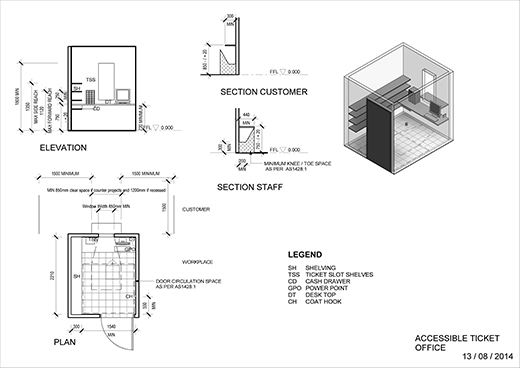The access provisions of Premises Standards 2010 have been incorporated into NCC Volume 1 BCA, effective from 1 May 2011.
In all public buildings, access is required to and within all areas normally used by the occupants. Fit-out criteria for these spaces are not included in the BCA. Uninformed design of fit-out can render a space inaccessible, despite its compliance with the BCA access provisions . Inaccessible buildings and spaces are at risk to complaint under the DDAct.
Accessible ticket office
1. APPLICATION
Ticket Offices are provided at transport facilities, entertainment and tourist venues. Consider the accessibility needs at both the customer and workplace sides.
2. DESIGN CONSIDERATIONS
This Design Guide contains criteria for elements which are beyond the scope of the NCC and the Premises Standards. As far as possible it does not repeat the mandatory requirements of the NCC.
A ticket office has a customer side and a workplace side. This note treats each as a discrete component. It is not necessary that they face each other, although the illustration shows that arrangement. AS1428.2 anticipates front-on approach from the customer side, but this imposes severe restraints on reach for both customer and staff and is not recommended.
Placement
Locate the accessible customer side component in conspicuous position, easily found from the point of entry. It may require a tactile path to it or a raised tactile/map near the entry, which also defines the layout of the area and how to find the counter.
Circulation
Provide space to enter, operate within, including turning around within the ticket office and leave. AS1428.1 Fig 5 requires a clear space of 2070mm x 1540mm in direction of travel, but if there is clear space under benches, shelves and counters, the clear space can reduce to 1770mm (uses 300mm of the under counter space). The width cannot be effectively reduced as door circulation must be maintained.
Door
Meet AS1428.1 including a minimum clear opening of 850mm and circulation clear of all fittings.
Counter on customer side (diagonal approach)
- Width - 850mm minimum
- Height - 850mm ± 20mm (see note 1)
- Depth above counter - 300mm minimum, 475mm maximum
- Depth below counter - 300mm minimum
- Knee-toe width below recessed counter - 1200mm minimum
- Knee-toe clearance height - 720mm minimum
- Circulation space depth - 1500mm minimum
- Circulation space length - 1500mm from each end of counter
- Width of the counter window - 450mm minimum
- Head of counter window - 1800mm minimum
Desk on workplace side
- Width - 850mm minimum
- Height - 750mm ± 20mm (see note 1)
- Depth above desk - 600mm maximum
- Depth below desk - provide knee/toe clearance to AS1428.1 Fig 45
- Width below desk - 820mm minimum
Adjustability
See Note 1
Fittings
Provide GPO 300mm maximum from the front of the desk and at 900mm-1100mm. Locate ticket slot shelves on the counter with front 300mm maximum from front of the counter.
- Height for side reach - 1350mm maximum
- Height for front reach - 1120mm maximum
Other shelving:
- Depth - 300mm maximum
- Height - 1350mm maximum
- Controls location - 500mm minimum from any internal corner and 300mm maximum from front of counter
Provide at least one coat hook at 1200mm – 1350mm height.
Other features
Consider provision of a sound augmentation system to assist communication with a person with a hearing impairment where the customer is not screened from the service provider. Provision is mandatory when screening is present. Avoid screening wherever possible.
Provide glare free illumination of minimum 450 lux over counter top.
Ensure the finish of counter and desk is not highly reflective.
3. REFERENCES
AS1428.1 – 2009 (Incorporating amendment No. 1 - 2010)
Design for Access and Mobility Part 1: General Requirements for Access—New Building Work
AS1428.2 – 1992
Design for Access and Mobility Part 2: Enhanced and Additional Requirements—Buildings and Facilities
4. DRAWINGS
Accessible ticket office
Note: 1 No individual table, counter or work top height and clearance under will suit all users with disabilities. A bench with easily adjustable height within the range of 700mm to 900 mm from the finished floor is preferred. For occasional use such as a customer counter, support facilities and the like the height should be 850mm±20mm. For workplace use such as desks, if a fixed height is provided the height should be 750mm±20mm. If a stool is available then a height of 850mm±20mm is acceptable for ambulant staff. If more than one facility is provided then the above should apply to the first and other dimension can apply to subsequent facilities.
Disclaimer
This content is provided by the Australian Institute of Architects for reference purposes and as general guidance. It does not take into account specific circumstances and should not be relied on in that way. It is not legal, financial, insurance, or other advice and you should seek independent verification or advice before relying on this content in circumstances where loss or damage may result. The Institute endeavours to publish content that is accurate at the time it is published, but does not accept responsibility for content that may or has become inaccurate over time. Using this website and content is subject to the Acumen User Licence.

